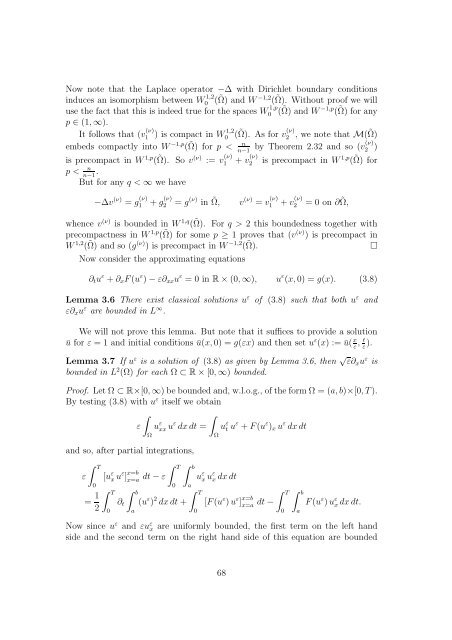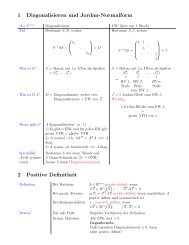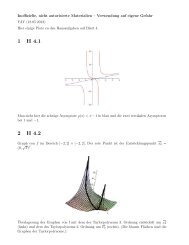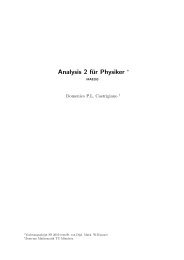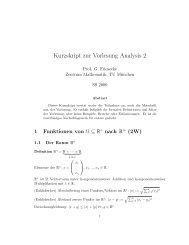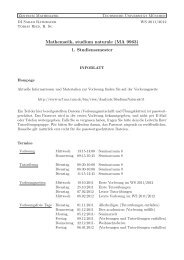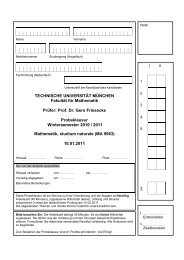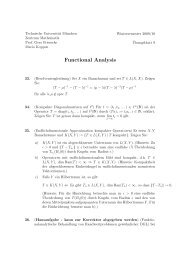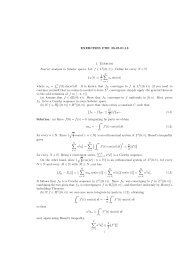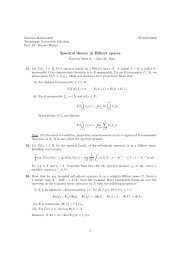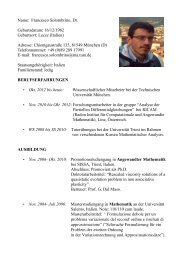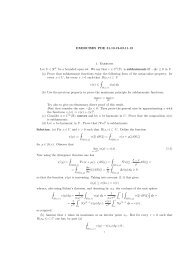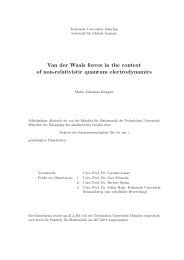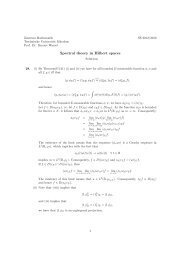Weak Convergence Methods for Nonlinear Partial Differential ...
Weak Convergence Methods for Nonlinear Partial Differential ...
Weak Convergence Methods for Nonlinear Partial Differential ...
Erfolgreiche ePaper selbst erstellen
Machen Sie aus Ihren PDF Publikationen ein blätterbares Flipbook mit unserer einzigartigen Google optimierten e-Paper Software.
Now note that the Laplace operator −∆ with Dirichlet boundary conditions<br />
induces an isomorphism between W 1,2<br />
0 (˜Ω) and W −1,2 (˜Ω). Without proof we will<br />
use the fact that this is indeed true <strong>for</strong> the spaces W 1,p<br />
0 (˜Ω) and W −1,p (˜Ω) <strong>for</strong> any<br />
p ∈ (1, ∞).<br />
It follows that (v (ν)<br />
1 ) is compact in W 1,2<br />
0 (˜Ω). As <strong>for</strong> v (ν)<br />
2 , we note that M(˜Ω)<br />
embeds compactly into W −1,p (˜Ω) <strong>for</strong> p <<br />
n by Theorem 2.32 and so (v(ν)<br />
n−1 2 )<br />
is precompact in W 1,p (˜Ω). So v (ν) := v (ν)<br />
1 + v (ν)<br />
2 is precompact in W 1,p (˜Ω) <strong>for</strong><br />
p < n . n−1<br />
But <strong>for</strong> any q < ∞ we have<br />
−∆v (ν) = g (ν)<br />
1 + g (ν)<br />
2 = g (ν) in ˜Ω, v (ν) = v (ν)<br />
1 + v (ν)<br />
2 = 0 on ∂˜Ω,<br />
whence v (ν) is bounded in W 1,q (˜Ω). For q > 2 this boundedness together with<br />
precompactness in W 1,p (˜Ω) <strong>for</strong> some p ≥ 1 proves that (v (ν) ) is precompact in<br />
W 1,2 (˜Ω) and so (g (ν) ) is precompact in W −1,2 (˜Ω).<br />
□<br />
Now consider the approximating equations<br />
∂ t u ε + ∂ x F(u ε ) − ε∂ xx u ε = 0 in R × (0, ∞), u ε (x, 0) = g(x). (3.8)<br />
Lemma 3.6 There exist classical solutions u ε of (3.8) such that both u ε and<br />
ε∂ x u ε are bounded in L ∞ .<br />
We will not prove this lemma. But note that it suffices to provide a solution<br />
ū <strong>for</strong> ε = 1 and initial conditions ū(x, 0) = g(εx) and then set u ε (x) := ū( x ε , t ε ).<br />
Lemma 3.7 If u ε is a solution of (3.8) as given by Lemma 3.6, then √ ε∂ x u ε is<br />
bounded in L 2 (Ω) <strong>for</strong> each Ω ⊂ R × [0, ∞) bounded.<br />
Proof. Let Ω ⊂ R×[0, ∞) be bounded and, w.l.o.g., of the <strong>for</strong>m Ω = (a, b)×[0, T).<br />
By testing (3.8) with u ε itself we obtain<br />
∫<br />
∫<br />
ε u ε xx u ε dxdt = u ε t u ε + F(u ε ) x u ε dxdt<br />
and so, after partial integrations,<br />
∫ T<br />
ε<br />
0<br />
= 1 2<br />
Ω<br />
[u ε x u ε ] x=b<br />
x=a dt − ε ∫ T<br />
∫ T<br />
0<br />
∫ b<br />
∂ t (u ε ) 2 dxdt +<br />
a<br />
0<br />
∫ b<br />
a<br />
∫ T<br />
0<br />
Ω<br />
u ε x u ε x dxdt<br />
[F(u ε ) u ε ] x=b<br />
x=a dt − ∫ T<br />
0<br />
∫ b<br />
a<br />
F(u ε ) u ε x dxdt.<br />
Now since u ε and εu ε x are uni<strong>for</strong>mly bounded, the first term on the left hand<br />
side and the second term on the right hand side of this equation are bounded<br />
68


